Sensitivity Analysis of Depth-Controlled Oriented Perforation in Horizontal Wells Based on the 3D Lattice Method
Abstract
1. Introduction
2. Method
- The ultra-low permeability reservoir does not consider the leak-off of fracturing fluid;
- The reservoir exhibits isotropic properties;
- The fluid has negligible compressibility.
3. Model Verification
4. Influence of Perforation Schemes on Fracture Initiation
4.1. Numerical Model
4.2. Result Analysis
5. Influence Factors of Fractures Initiation in Depth-Controlled Oriented Perforation
5.1. Injection Rate
5.2. Elastic Modulus
5.3. Horizontal Stress Difference
6. Conclusions
- (1)
- This study establishes a 3D lattice method model to explore the fracture initiation mechanisms of depth-controlled oriented perforation under various operational parameters and geological conditions.
- (2)
- Depth-controlled oriented perforation ensures uniform fracture initiation at the perforations on both sides, effectively overcoming stress interference at the central perforations, thereby improving fracture formation efficiency.
- (3)
- Depth-controlled oriented perforation is more suitable for formations with high horizontal stress differences and high elastic moduli, facilitating the formation of narrow and long fractures.
- (4)
- Under high injection flow rate conditions, the fracture initiation pressure of depth-controlled oriented perforation increases; therefore, it is essential to control the injection rate appropriately to achieve effective fracture initiation.
Author Contributions
Funding
Data Availability Statement
Conflicts of Interest
References
- Liu, G. Challenges and Countermeasures of Log Evaluation in Unconventional Petroleum Exploration and Development. Pet. Explor. Dev. 2021, 48, 1033–1047. [Google Scholar] [CrossRef]
- Kokkinos, N.C.; Nkagbu, D.C.; Marmanis, D.I.; Dermentzis, K.I.; Maliaris, G. Evolution of Unconventional Hydrocarbons: Past, Present, Future and Environmental FootPrin. J. Eng. Sci. Technol. Rev. 2022, 4, 15–24. [Google Scholar] [CrossRef]
- Cong, Z.; Li, Y.; Pan, Y.; Liu, B.; Shi, Y.; Wei, J.; Li, W. Study on CO2 Foam Fracturing Model and Fracture Propagation Simulation. Energy 2022, 238, 121778. [Google Scholar] [CrossRef]
- Zhang, B.; Zhang, C.; Chen, Z. Analysis of high fracturing initiation pressure in low permeability reservoirs in the East China Sea. Chin. J. Appl. Mech. 2022, 39, 403–408. [Google Scholar]
- Lei, Q.; Weng, D.; Guan, B.; Shi, J.; Cai, B.; He, C.; Sun, Q.; Huang, R. Shale Oil and Gas Exploitation in China: Technical Comparison with US and Development Suggestions. Pet. Explor. Dev. 2023, 50, 944–954. [Google Scholar] [CrossRef]
- Zhang, J.; Li, Y.; Pan, Y.; Wang, X.; Yan, M.; Shi, X.; Zhou, X.; Li, H. Experiments and Analysis on the Influence of Multiple Closed Cemented Natural Fractures on Hydraulic Fracture Propagation in a Tight Sandstone Reservoir. Eng. Geol. 2021, 281, 105981. [Google Scholar] [CrossRef]
- Zhang, J.; Yu, Q.; Li, Y.; Pan, Z.; Liu, B. Hydraulic Fracture Vertical Propagation Mechanism in Interlayered Brittle Shale Formations: An Experimental Investigation. Rock Mech. Rock Eng. 2022, 56, 199–200. [Google Scholar] [CrossRef]
- Hossain, M.M.; Rahman, M.K.; Rahman, S.S. Hydraulic Fracture Initiation and Propagation: Roles of Wellbore Trajectory, Perforation and Stress Regimes. J. Pet. Sci. Eng. 2000, 27, 129–149. [Google Scholar] [CrossRef]
- Jin, Y.; Zhang, X.; Chen, M. Initiation Pressure Models for Hydraulic Fracturing of Vertical Wells in Naturally Fractured Formation. Acta Pet. Sin. 2005, 26, 113. [Google Scholar]
- Guo, J.; Deng, Y.; Zhao, J. Study on Breakdown Pressure of Hydraulic Fracturing for Extended Reach Wells With Perforation Completion. NGI 2006, 26, 105–107. [Google Scholar]
- Tananykhin, D.S.; Struchkov, I.A.; Khormali, A.; Roschin, P.V. Investigation of The Influences of Asphaltene Deposition on Oilfield Development Using Reservoir Simulation. Explor. Dev. 2022, 49, 1138–1149. [Google Scholar] [CrossRef]
- Li, Y.; Peng, G.; Tang, J.; Zhang, J.; Zhao, W.; Liu, B.; Pan, Y. Thermo-Hydro-Mechanical Coupling Simulation for Fracture Propagation in CO2 Fracturing Based on Phase-Field Model. Energy 2023, 284, 128629. [Google Scholar] [CrossRef]
- Lian, Z.; Meng, Y.; Tong, M. A New Method of Numerical Simulation for Perforation Completion of Fracture Formation. In Proceedings of the SPE Asia Pacific Oil and Gas Conference and Exhibition, Brisbane, Australia, 16–18 October 2000; OnePetro: Richardson, TX, USA, 2000. [Google Scholar]
- Wanniarachchi, W.A.M.; Ranjith, P.G.; Li, J.C.; Perera, M.S.A. Numerical Simulation of Foam-Based Hydraulic Fracturing to Optimise Perforation Spacing and to Investigate Effect of Dip Angle on Hydraulic Fracturing. J. Pet. Sci. Eng. 2019, 172, 83–96. [Google Scholar] [CrossRef]
- Zhang, X.; Jeffrey, R.G.; Bunger, A.P.; Thiercelin, M. Initiation and Growth of a Hydraulic Fracture from a Circular Wellbore. Int. J. Rock Mech. Min. Sci. 2011, 48, 984–995. [Google Scholar] [CrossRef]
- Sepehri, J.; Soliman, M.Y.; Morse, S.M. Application of Extended Finite Element Method (XFEM) to Simulate Hydraulic Fracture Propagation from Oriented Perforations. In Proceedings of the SPE Hydraulic Fracturing Technology Conference and Exhibition, The Woodlands, TX, USA, 3–5 February 2015; p. D031S007R006. [Google Scholar]
- Dong, Z.; Tang, S. Numerical Study of Near-Wellbore Hydraulic Fracture Propagation. Theor. Appl. Fract. Mech. 2019, 103, 10227. [Google Scholar] [CrossRef]
- Ferguson, W.; Richards, G.; Bere, A.; Mutlu, U.; Paw, F. Modelling Near-Wellbore Hydraulic Fracture Branching, Complexity and Tortuosity: A Case Study Based on a Fully Coupled Geomechanical Modelling Approach. In Proceedings of the SPE Hydraulic Fracturing Technology Conference and Exhibition, The Woodlands, TX, USA, 23–25 January 2018; p. D021S004R001. [Google Scholar]
- Shan, Q.; Zhang, R.; Jiang, Y.; Luan, H.; Li, Q. Complexity of Near-Wellbore Hydraulic Fracture Morphology around Perforated Wells with Various Orientations in Tight Reservoir. J. Nat. Gas Sci. Eng. 2022, 102, 104550. [Google Scholar] [CrossRef]
- Shan, Q.; Zhang, R.; Jiang, Y. Complexity and Tortuosity Hydraulic Fracture Morphology Due to Near-Wellbore Nonplanar Propagation from Perforated Horizontal Wells. J. Nat. Gas Sci. Eng. 2021, 89, 103884. [Google Scholar] [CrossRef]
- Peng, F.; Sheng, Q.; Feng, G.; Wen, L.; Wei, Z. Numerical Investigation on Hydraulic Fracture Propagation and Multi-Perforation Fracturing for Horizontal Well in Longmaxi Shale Reservoir. Theor. Appl. Fract. Mech. 2023, 125, 103921. [Google Scholar]
- Zhang, F.; Mack, M. Modeling of Hydraulic Fracture Initiation from Perforation Tunnels Using the 3D Lattice Method. In Proceedings of the ARMA US Rock Mechanics/Geomechanics Symposium, Houston, TX, USA, 26–29 June 2016. [Google Scholar]
- Huang, L.; Liu, J.; Zhang, F.; Fu, H.; Zhu, H.; Damjanac, B. 3D Lattice Modeling of Hydraulic Fracture Initiation and Near-Wellbore Propagation for Different Perforation Models. J. Pet. Sci. Eng. 2020, 191, 107169. [Google Scholar] [CrossRef]
- Wang, X.; Zhang, F.; Tang, M.; Du, X.; Tang, J. Effect of Stress Shadow Caused by Multistage Fracturing from Multiple Well Pads on Fracture Initiation and Near-Wellbore Propagation from Infill Wells. SPE J. 2022, 27, 204–222. [Google Scholar] [CrossRef]
- Li, Y.; Hubuqin; Wu, J.; Zhang, J.; Yang, H.; Zeng, B.; Xiao, Y.; Liu, J. Optimization Method of Oriented Perforation Parameters Improving Uneven Fractures Initiation for Horizontal Well Fracturing. Fuel 2023, 349, 12875. [Google Scholar] [CrossRef]
- Jiang, H.; Chen, M.; Zhang, G.; Jin, Y.; Zhao, Z.; Zhu, G. Impact of oriented perforation on hydraulic fracture initiation and propagation. Chin. J. Rock Mech. Eng. 2009, 28, 1321–1326. [Google Scholar]
- Fu, H.; Zhang, F.; Weng, D.; Liu, Y.; Yan, Y.; Liang, T.; Guan, B.; Wang, X.; Zheng, W. The Simulation Method Research of Hydraulic Fracture Initiation with Perforations. In Proceedings of the International Field Exploration and Development Conference 2018 8th, Xi’an, China, 18–20 September 2018; Springer: Singapore, 2020; pp. 1229–1240. [Google Scholar]
- Li, X.; Hofmann, H.; Yoshioka, K.; Luo, Y.; Liang, Y. Phase-Field Modelling of Interactions Between Hydraulic Fractures and Natural Fractures. Rock Mech. Rock Eng. 2022, 55, 6227–6247. [Google Scholar] [CrossRef]


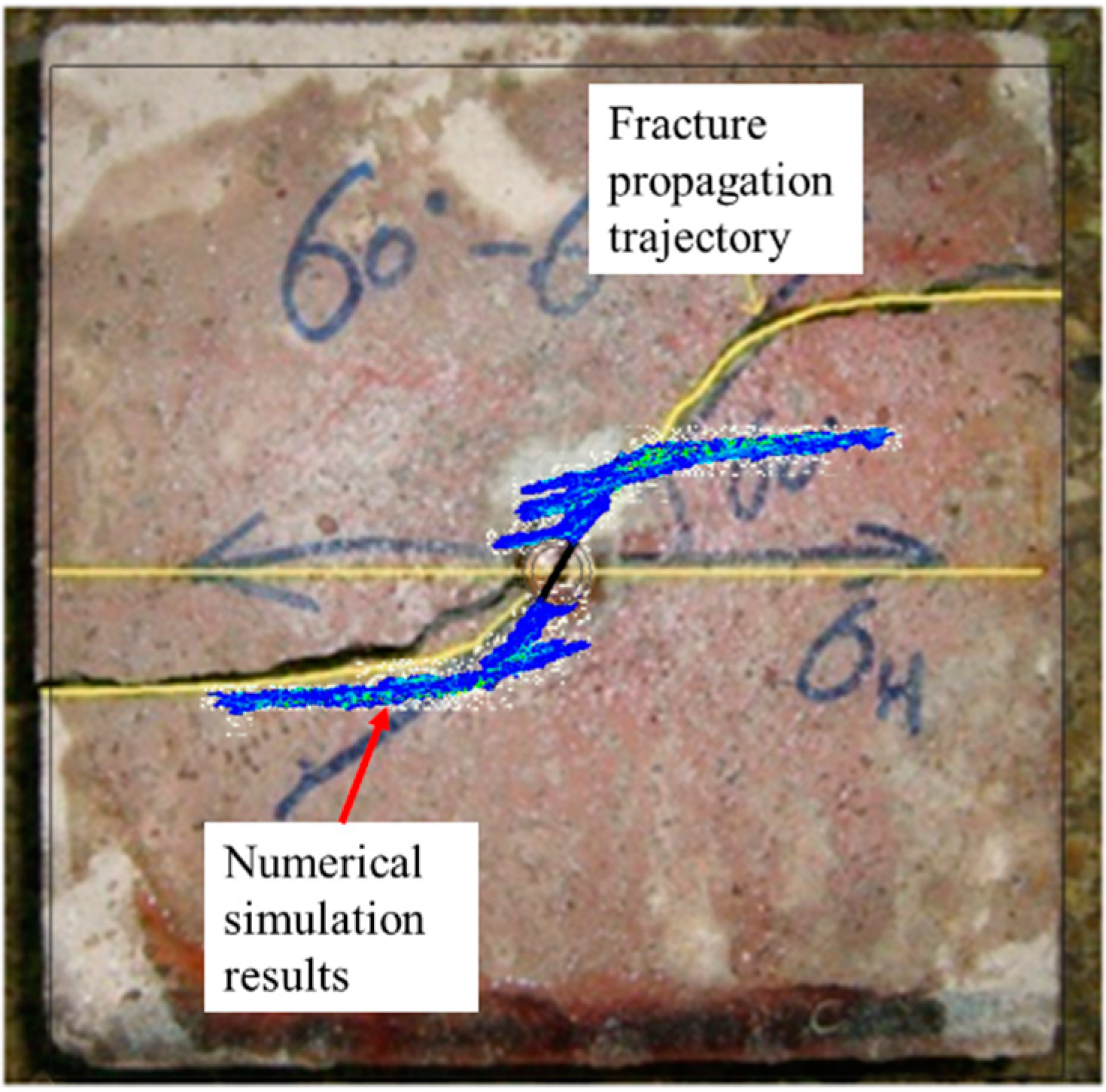
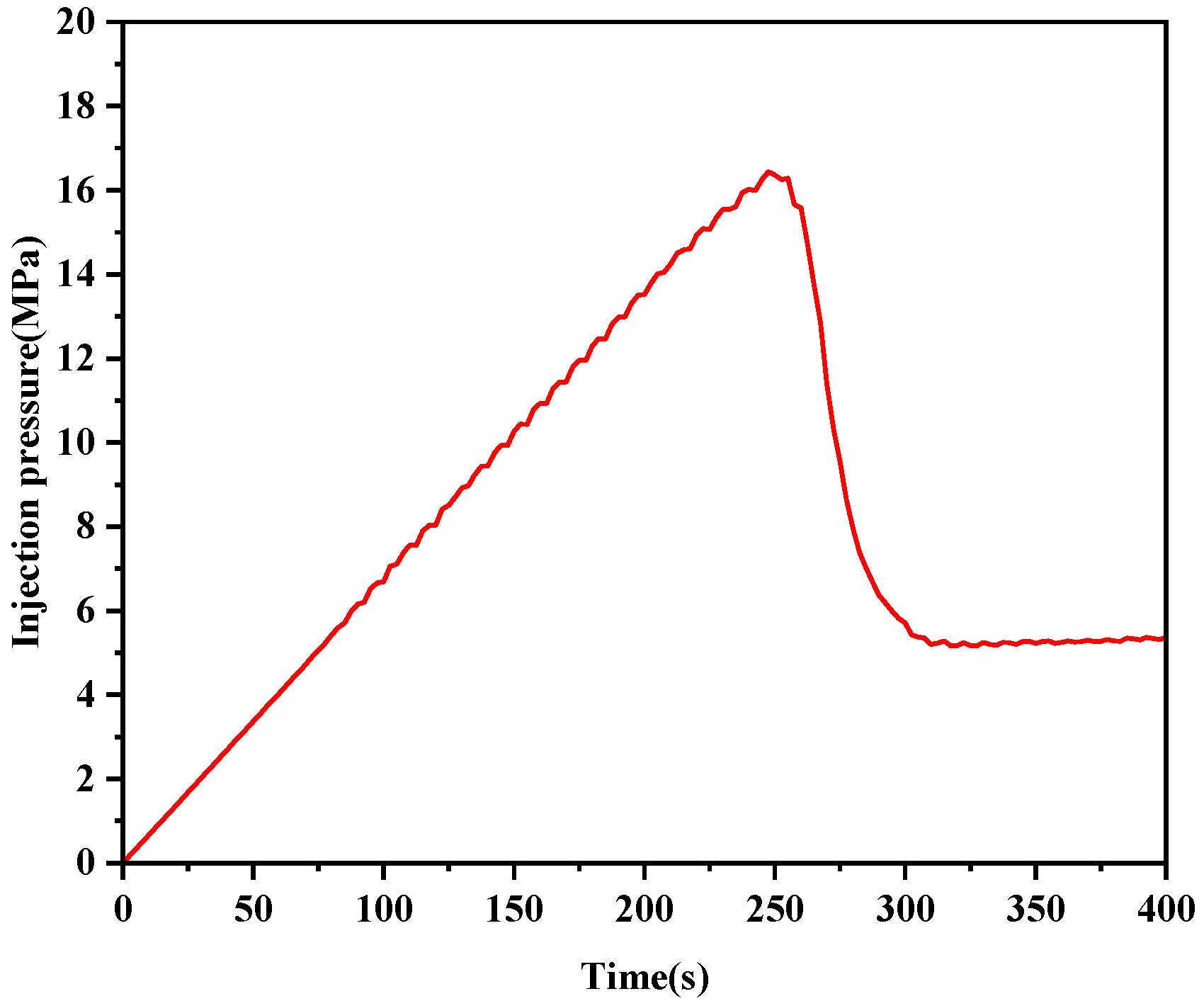
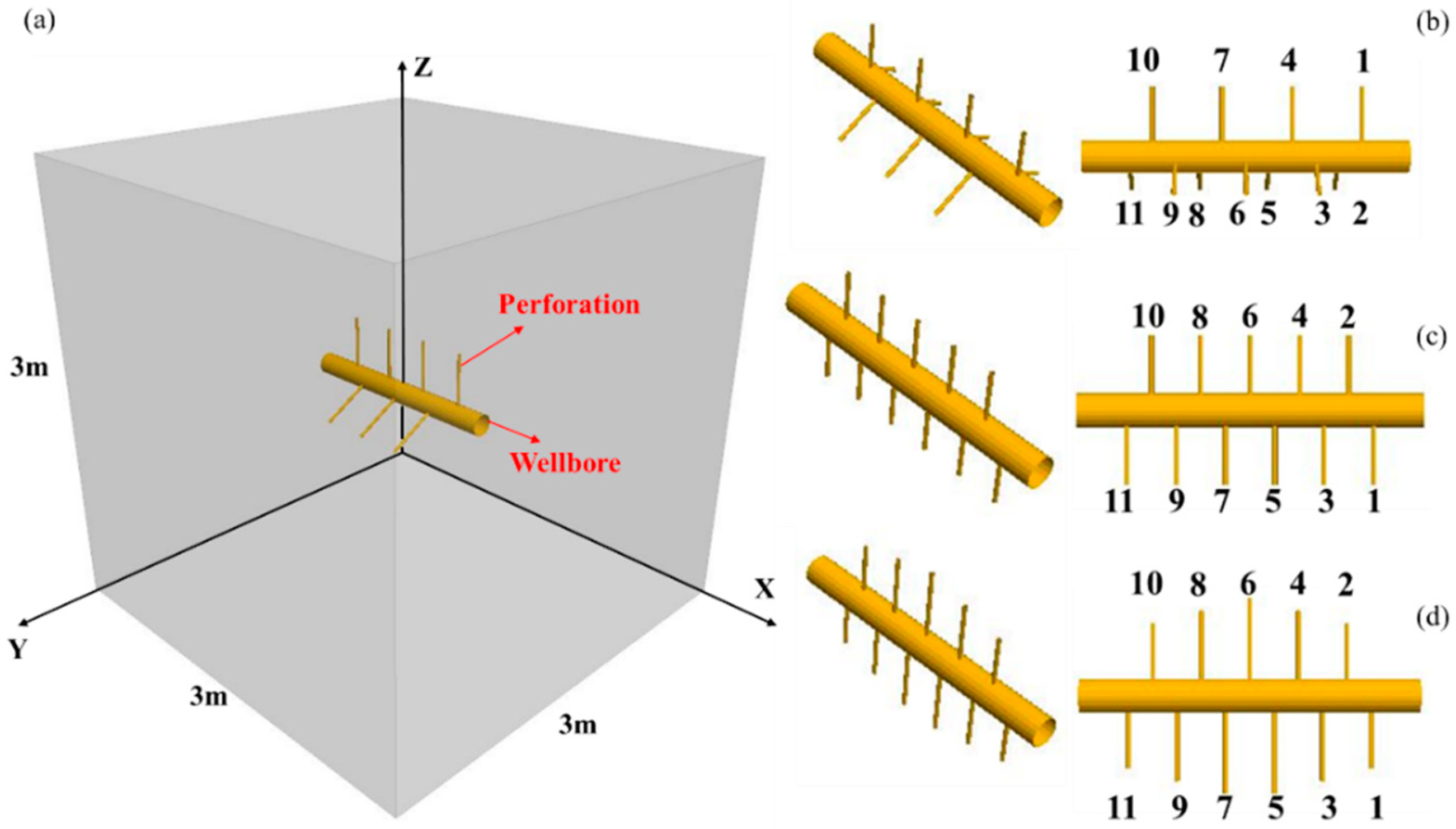

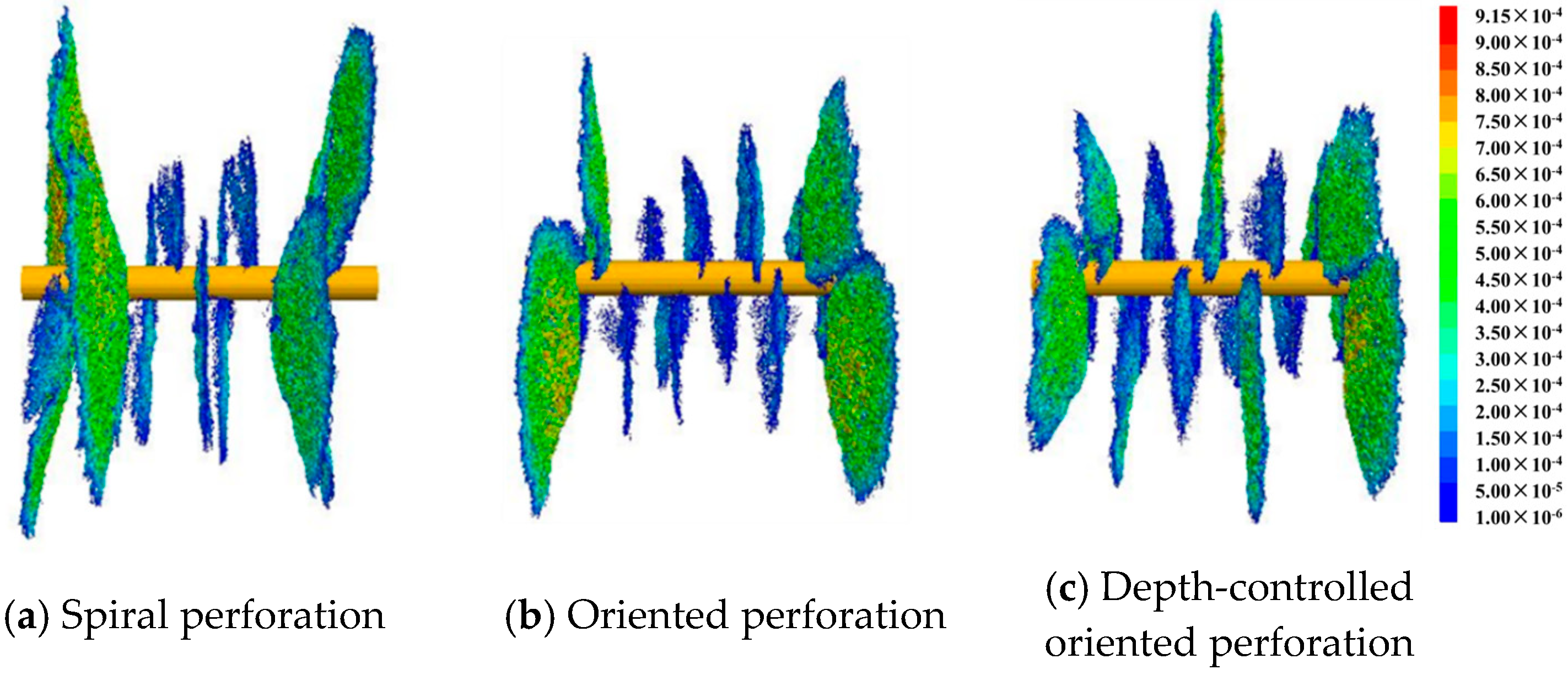
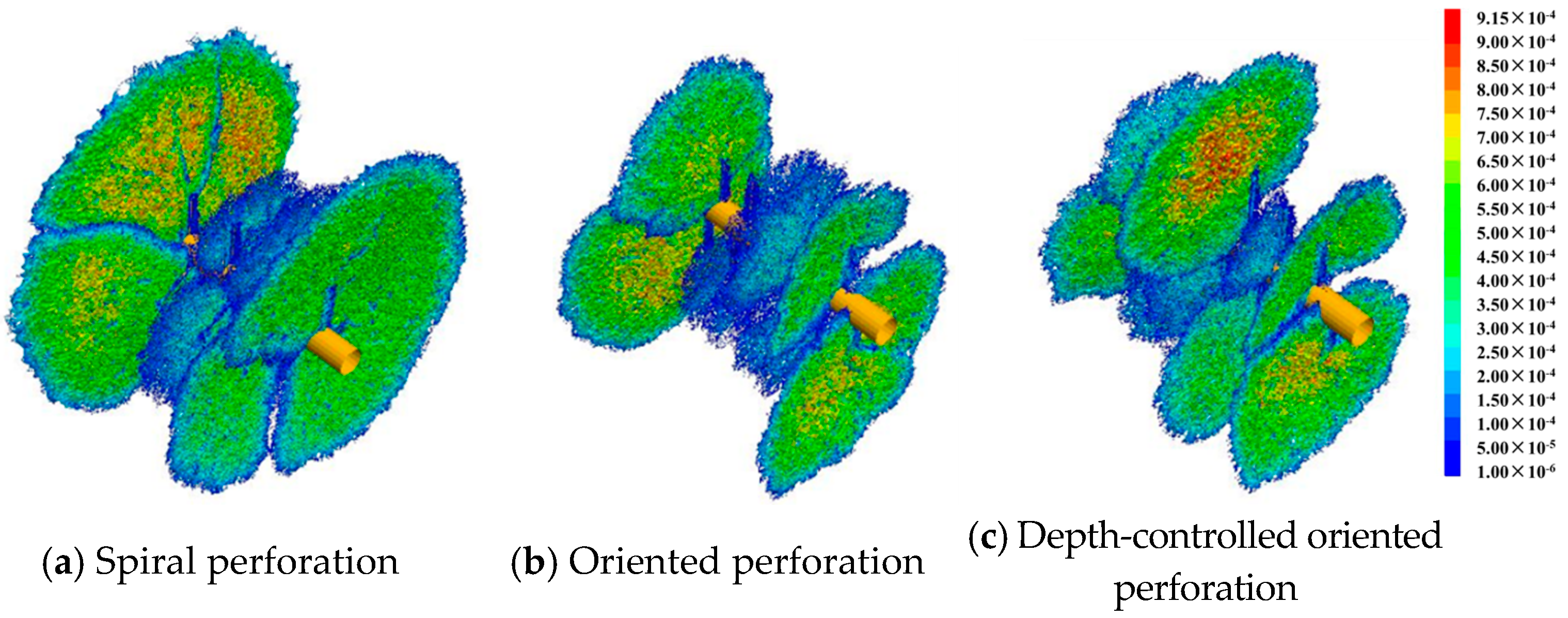
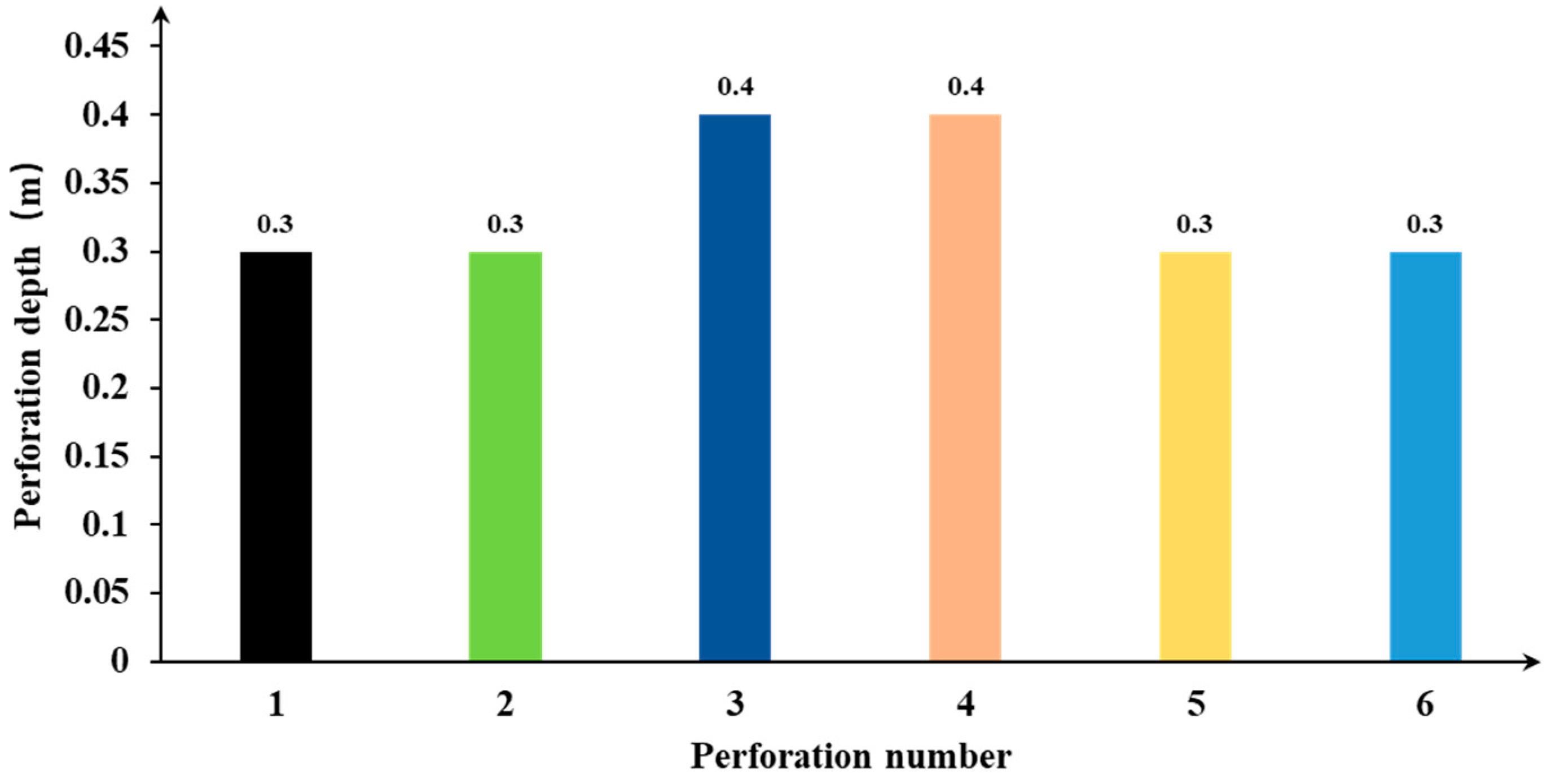
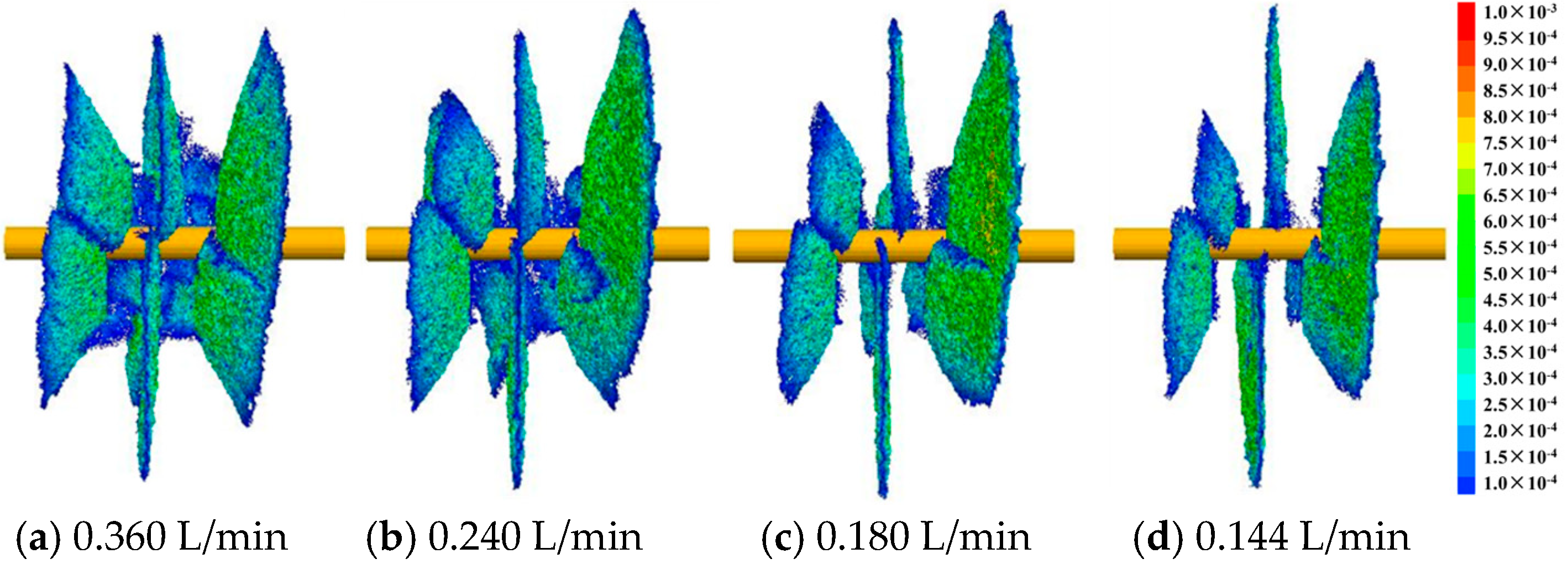
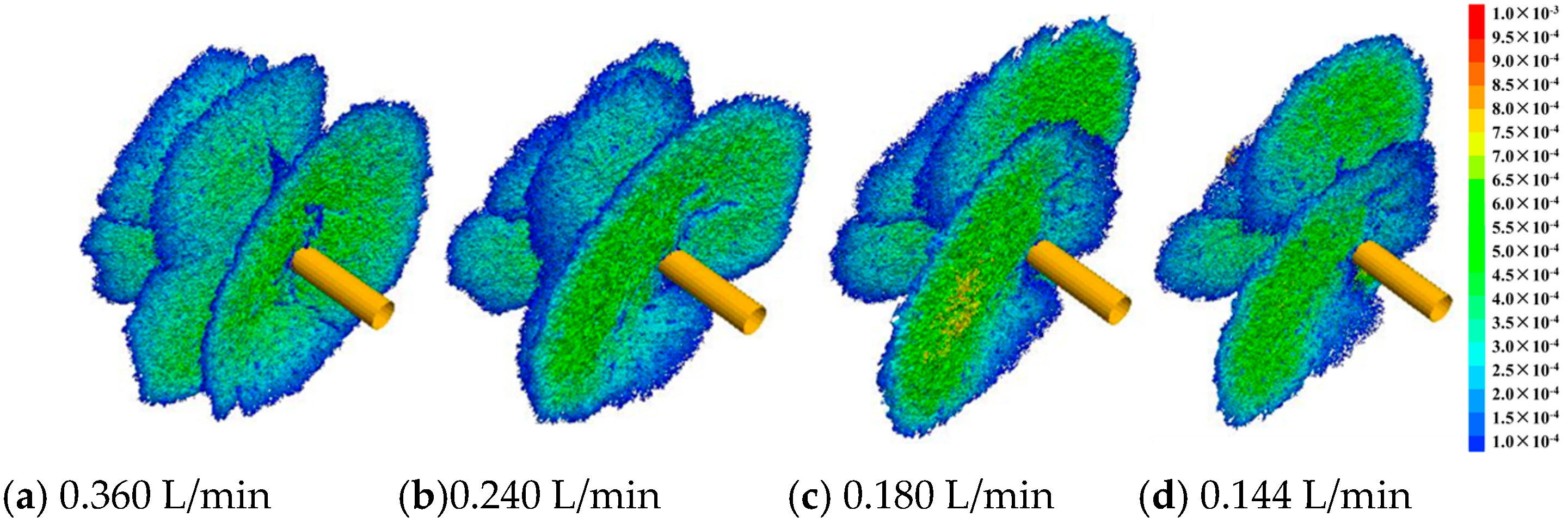

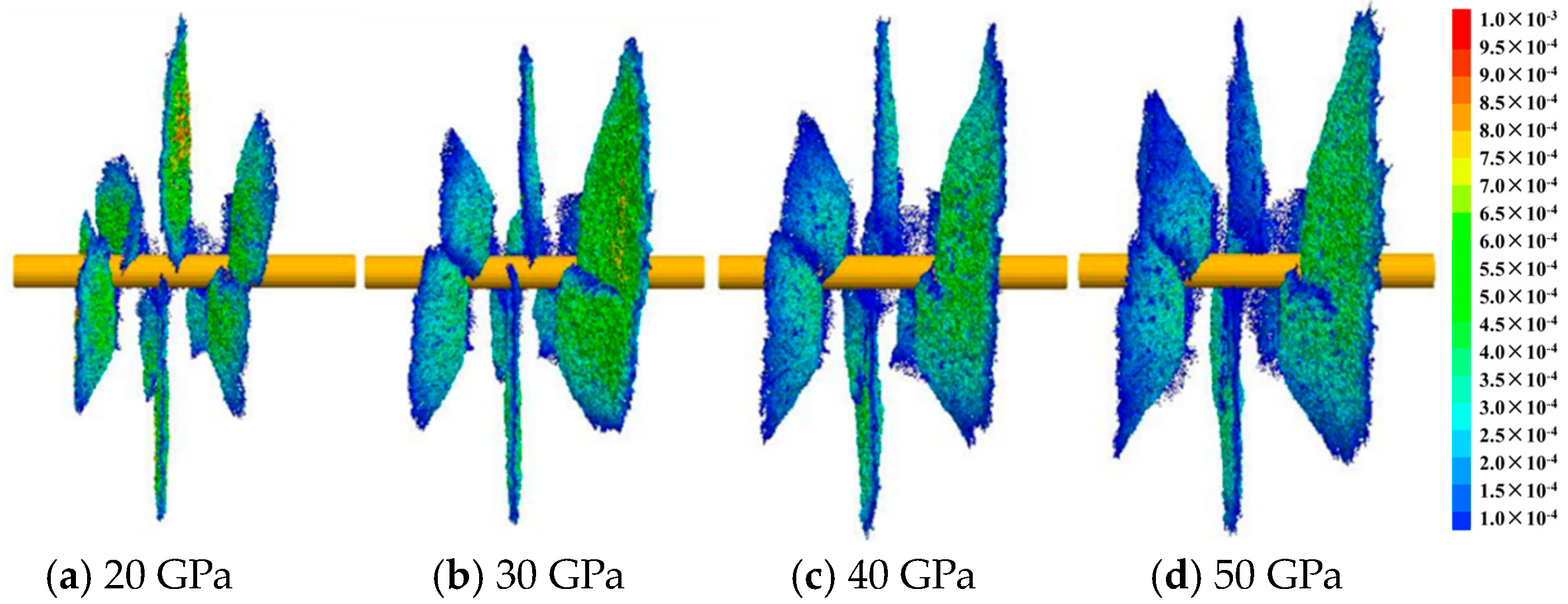

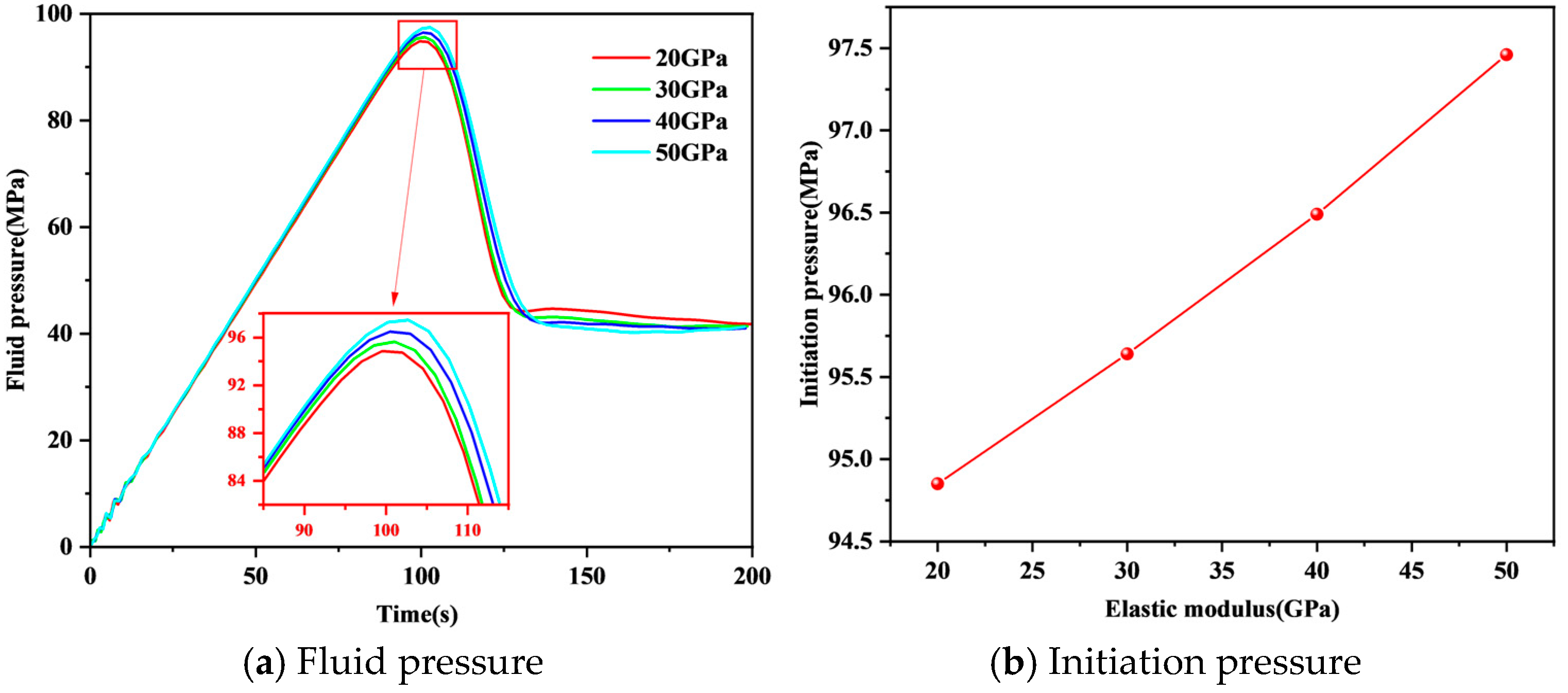
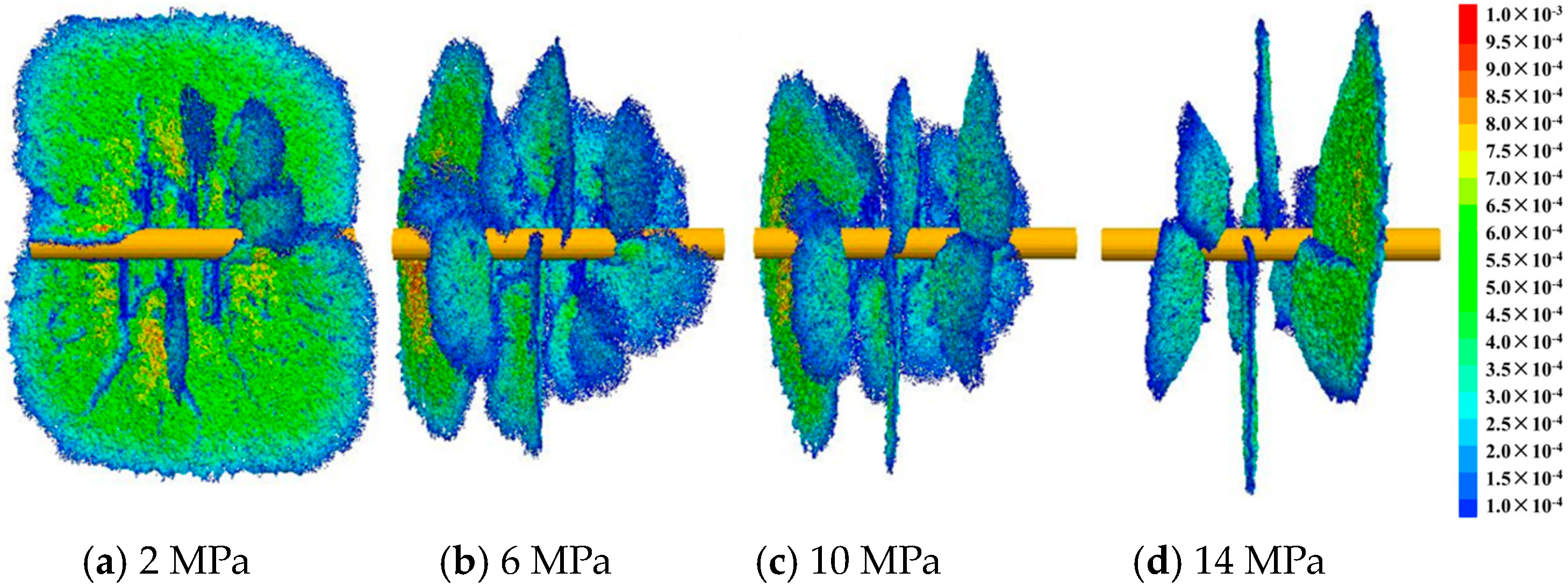
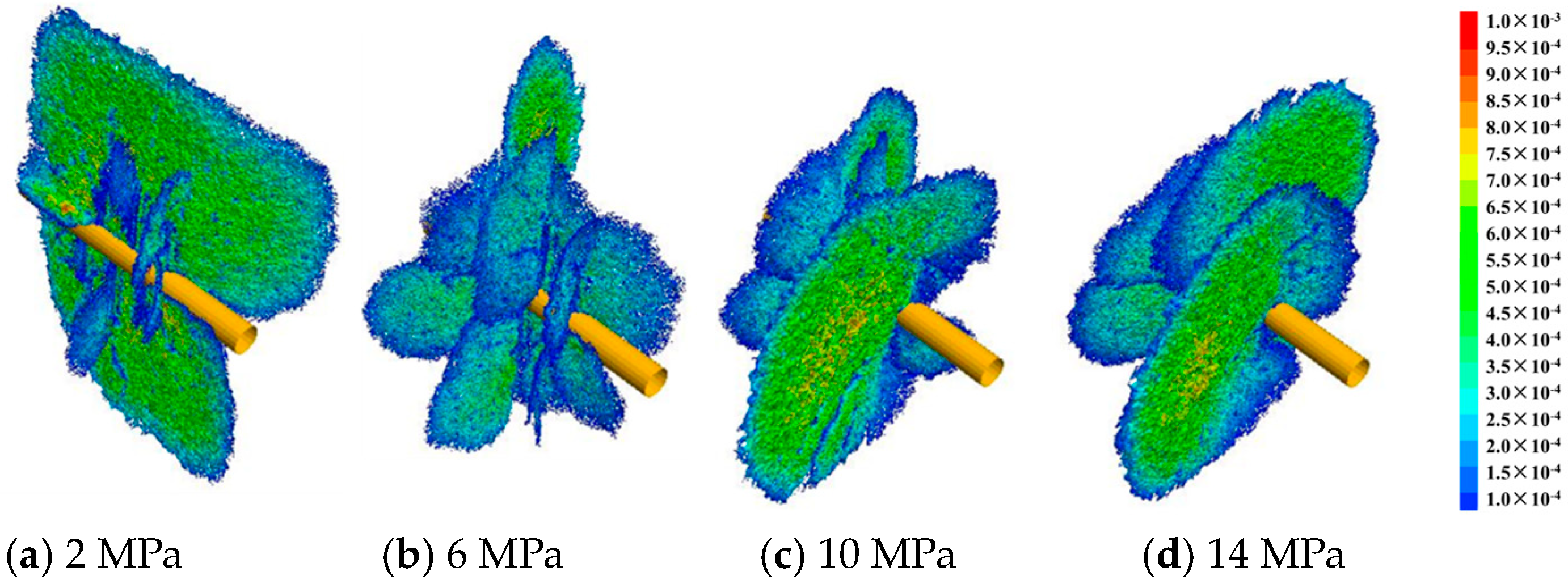
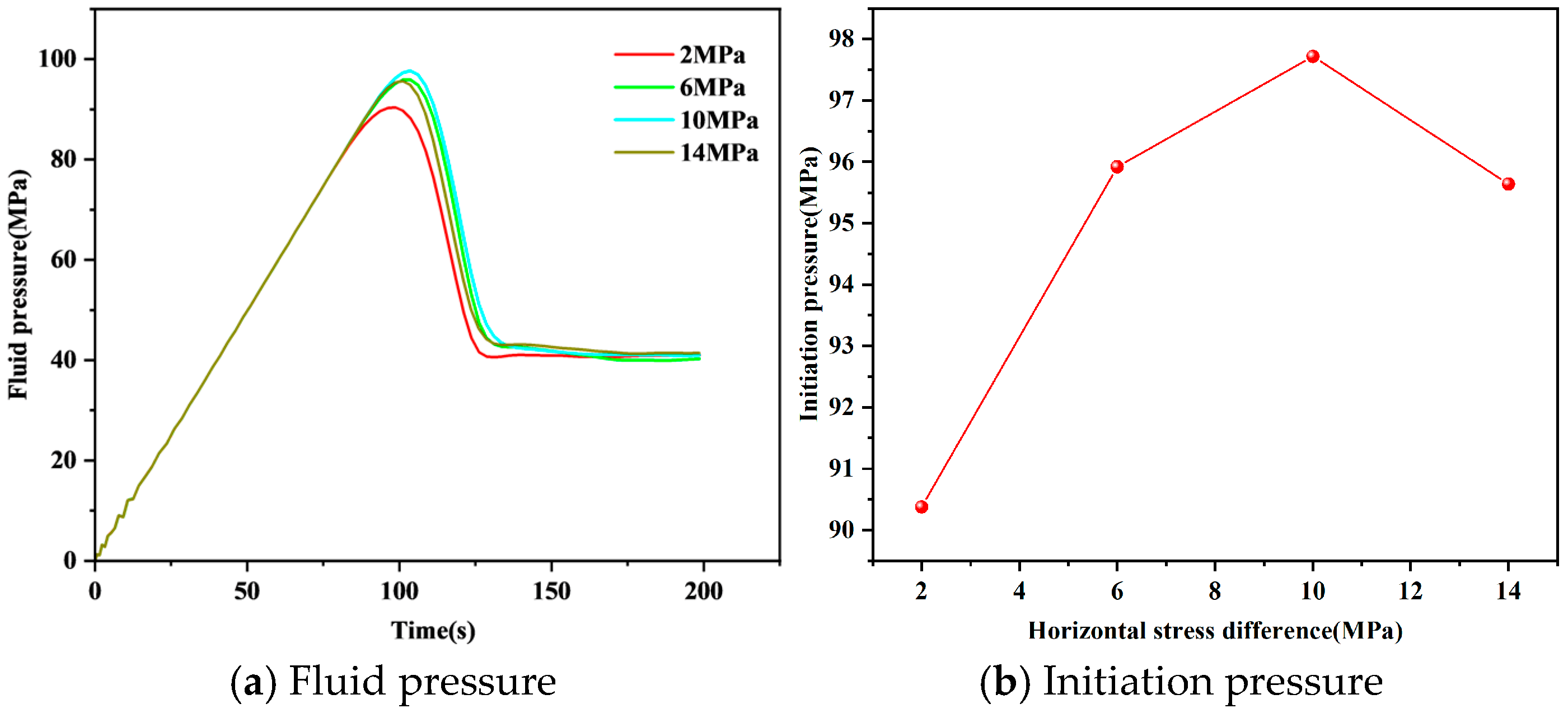
Disclaimer/Publisher’s Note: The statements, opinions and data contained in all publications are solely those of the individual author(s) and contributor(s) and not of MDPI and/or the editor(s). MDPI and/or the editor(s) disclaim responsibility for any injury to people or property resulting from any ideas, methods, instructions or products referred to in the content. |
© 2024 by the authors. Licensee MDPI, Basel, Switzerland. This article is an open access article distributed under the terms and conditions of the Creative Commons Attribution (CC BY) license (https://creativecommons.org/licenses/by/4.0/).
Share and Cite
Zhang, H.; Gou, Y.; Cheng, D.; Zhang, F.; Jia, X.; Gao, R.; Li, Y. Sensitivity Analysis of Depth-Controlled Oriented Perforation in Horizontal Wells Based on the 3D Lattice Method. Processes 2024, 12, 2192. https://doi.org/10.3390/pr12102192
Zhang H, Gou Y, Cheng D, Zhang F, Jia X, Gao R, Li Y. Sensitivity Analysis of Depth-Controlled Oriented Perforation in Horizontal Wells Based on the 3D Lattice Method. Processes. 2024; 12(10):2192. https://doi.org/10.3390/pr12102192
Chicago/Turabian StyleZhang, Haining, Yanhong Gou, Daojie Cheng, Fengsheng Zhang, Xunan Jia, Rui Gao, and Yuwei Li. 2024. "Sensitivity Analysis of Depth-Controlled Oriented Perforation in Horizontal Wells Based on the 3D Lattice Method" Processes 12, no. 10: 2192. https://doi.org/10.3390/pr12102192
APA StyleZhang, H., Gou, Y., Cheng, D., Zhang, F., Jia, X., Gao, R., & Li, Y. (2024). Sensitivity Analysis of Depth-Controlled Oriented Perforation in Horizontal Wells Based on the 3D Lattice Method. Processes, 12(10), 2192. https://doi.org/10.3390/pr12102192




